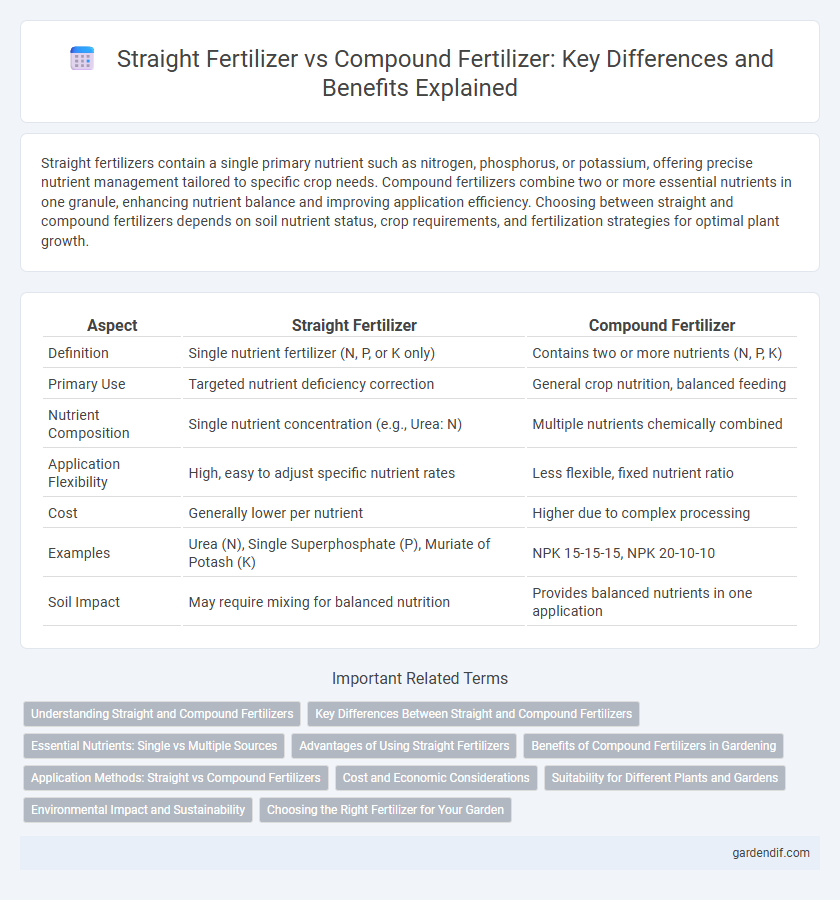
Straight fertilizer vs Compound fertilizer Illustration
Straight fertilizers contain a single primary nutrient such as nitrogen, phosphorus, or potassium, offering precise nutrient management tailored to specific crop needs. Compound fertilizers combine two or more essential nutrients in one granule, enhancing nutrient balance and improving application efficiency. Choosing between straight and compound fertilizers depends on soil nutrient status, crop requirements, and fertilization strategies for optimal plant growth.
Table of Comparison
| Aspect | Straight Fertilizer | Compound Fertilizer |
|---|---|---|
| Definition | Single nutrient fertilizer (N, P, or K only) | Contains two or more nutrients (N, P, K) |
| Primary Use | Targeted nutrient deficiency correction | General crop nutrition, balanced feeding |
| Nutrient Composition | Single nutrient concentration (e.g., Urea: N) | Multiple nutrients chemically combined |
| Application Flexibility | High, easy to adjust specific nutrient rates | Less flexible, fixed nutrient ratio |
| Cost | Generally lower per nutrient | Higher due to complex processing |
| Examples | Urea (N), Single Superphosphate (P), Muriate of Potash (K) | NPK 15-15-15, NPK 20-10-10 |
| Soil Impact | May require mixing for balanced nutrition | Provides balanced nutrients in one application |
Understanding Straight and Compound Fertilizers
Straight fertilizers contain a single primary nutrient such as nitrogen, phosphorus, or potassium, enabling precise nutrient management based on specific crop needs. Compound fertilizers combine two or more primary nutrients in one product, offering balanced nutrition that supports diverse plant growth stages. Understanding the differences between straight and compound fertilizers helps optimize soil fertility and enhance crop yield efficiency.
Key Differences Between Straight and Compound Fertilizers
Straight fertilizers contain a single nutrient such as nitrogen, phosphorus, or potassium, allowing precise nutrient management tailored to specific crop needs. Compound fertilizers combine two or more essential nutrients in fixed proportions, promoting balanced nutrition and simplifying application for diverse soil conditions. Choosing between straight and compound fertilizers depends on soil analysis, crop requirements, and nutrient delivery efficiency to maximize yield and reduce environmental impact.
Essential Nutrients: Single vs Multiple Sources
Straight fertilizer supplies essential nutrients such as nitrogen, phosphorus, or potassium individually, allowing precise nutrient management tailored to specific crop needs. Compound fertilizer contains multiple essential nutrients combined in one formulation, providing balanced nutrition for general growth requirements. Farmers choose straight fertilizers for targeted nutrient deficiencies and compound fertilizers for convenient, all-in-one nutrient delivery.
Advantages of Using Straight Fertilizers
Straight fertilizers provide precise nutrient delivery by containing a single primary nutrient such as nitrogen, phosphorus, or potassium, allowing farmers to tailor applications based on specific soil deficiencies. They offer flexibility in nutrient management, enabling targeted correction without the risk of nutrient imbalance often associated with compound fertilizers. Their cost-effectiveness and ease of blending with other fertilizers improve crop-specific nutrient optimization and overall soil health management.
Benefits of Compound Fertilizers in Gardening
Compound fertilizers provide balanced nutrition by combining essential nutrients like nitrogen, phosphorus, and potassium in precise ratios, promoting uniform plant growth. Their ease of application reduces the risk of nutrient deficiencies and improves soil fertility management compared to straight fertilizers. Enhanced nutrient availability in compound fertilizers supports higher yields and healthier plants in gardening environments.
Application Methods: Straight vs Compound Fertilizers
Straight fertilizers contain a single nutrient such as nitrogen, phosphorus, or potassium, allowing precise application tailored to crop-specific nutrient deficiencies. Compound fertilizers blend two or more essential nutrients in fixed proportions, offering balanced nutrition through simplified application methods like broadcasting or fertigation. Choosing between straight and compound fertilizers depends on soil test results, crop requirements, and the desired flexibility in nutrient management.
Cost and Economic Considerations
Straight fertilizers, containing a single nutrient like nitrogen, phosphorus, or potassium, typically have lower upfront costs and allow farmers to tailor nutrient application precisely to crop needs, reducing waste and enhancing cost-efficiency. Compound fertilizers blend multiple essential nutrients into one granule, often resulting in higher prices but offering convenience, improved nutrient balance, and potentially better crop yields, which can offset initial expenses. Economic considerations should weigh immediate cost differences against long-term benefits in nutrient availability, application efficiency, and yield outcomes when selecting between straight and compound fertilizers.
Suitability for Different Plants and Gardens
Straight fertilizers supply a single nutrient like nitrogen, phosphorus, or potassium, making them ideal for plants with specific nutrient deficiencies or targeted garden applications. Compound fertilizers contain a balanced mix of essential nutrients, supporting overall plant growth and are well-suited for general garden use or plants requiring multiple nutrients simultaneously. Selecting between straight and compound fertilizers depends on soil test results and the nutrient demands of particular plants, ensuring optimal growth and yield.
Environmental Impact and Sustainability
Straight fertilizers consist of a single nutrient, making it easier to manage and reduce excessive nutrient application that can lead to environmental pollution such as nitrate leaching and phosphorus runoff. Compound fertilizers combine multiple nutrients in fixed ratios, potentially increasing the risk of nutrient imbalance and environmental harm if not precisely matched to crop needs. Sustainable fertilizer practices favor the use of straight fertilizers for targeted nutrient management, minimizing ecological disruption and promoting soil health.
Choosing the Right Fertilizer for Your Garden
Straight fertilizers contain a single primary nutrient such as nitrogen, phosphorus, or potassium, making them ideal for addressing specific soil deficiencies and promoting targeted plant growth. Compound fertilizers combine two or more essential nutrients in a balanced formula, offering a convenient all-in-one solution that supports overall plant health and development. Selecting the right fertilizer depends on soil testing results, plant nutritional needs, and garden growth stages to optimize nutrient uptake and maximize yield.
Straight fertilizer vs Compound fertilizer Infographic

 gardendif.com
gardendif.com